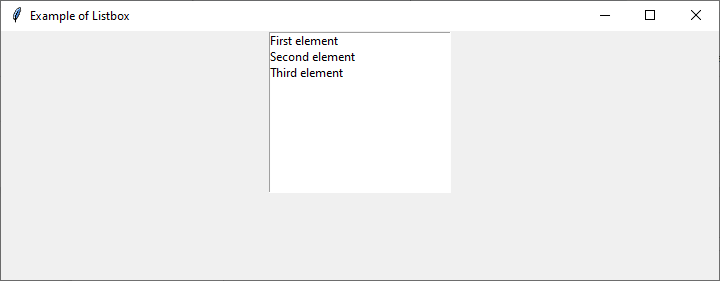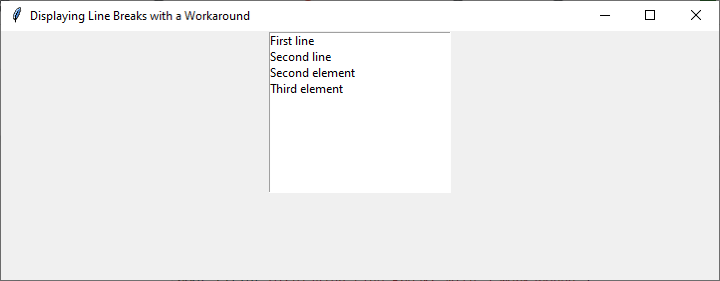
 Data Structure
Data Structure Networking
Networking RDBMS
RDBMS Operating System
Operating System Java
Java MS Excel
MS Excel iOS
iOS HTML
HTML CSS
CSS Android
Android Python
Python C Programming
C Programming C++
C++ C#
C# MongoDB
MongoDB MySQL
MySQL Javascript
Javascript PHP
PHP
- Selected Reading
- UPSC IAS Exams Notes
- Developer's Best Practices
- Questions and Answers
- Effective Resume Writing
- HR Interview Questions
- Computer Glossary
- Who is Who
How to make a single Tkinter Listbox element appear with line breaks?
Tkinter, a popular Python library for creating graphical user interfaces (GUI), provides a variety of widgets for building interactive applications. One commonly used widget is the Listbox, which displays a list of selectable items. By default, each item in a Listbox appears as a single line of text. However, there are situations where you might want to display a single Listbox element with line breaks to enhance readability or present multiline information. In this article, we will explore a workaround to achieve this effect in Tkinter.
Let's start by creating a basic Tkinter application with a Listbox widget
Example
import tkinter as tk
root = tk.Tk()
root.geometry("720x250")
root.title("Example of Listbox")
listbox = tk.Listbox(root, width=30, height=10)
listbox.pack()
items = ["First element", "Second element", "Third element"]
for item in items:
listbox.insert(tk.END, item)
root.mainloop()
In the above code, we import the necessary tkinter module and create a Tkinter application with a root window. We set the title of the window to "Listbox Example". Next, we create a Listbox widget named listbox with a specified width and height, and pack it into the root window.
We define a list named items containing three elements. Then, we use a loop to insert each item into the Listbox using the insert() method. The insert() method takes two arguments: the index at which to insert the item (in this case, we use tk.END to insert at the end), and the text to display for the item.
Output
When you run the code, a Tkinter window will appear with a Listbox containing the three elements from the items list.

By default, each element in the Listbox appears as a single line of text. However, there are scenarios where you might want to display a single Listbox element with line breaks, allowing for multiline content within that element.
Displaying Line Breaks with a Workaround
Although the Listbox widget in Tkinter does not provide a direct option to display line breaks within an element, we can achieve the desired effect through a workaround. The workaround involves splitting the text into multiple items within the Listbox, where each item represents a separate line of text.
To demonstrate this approach, let's modify our previous code
Example
import tkinter as tk
def insert_with_line_breaks(text):
lines = text.split("\n")
for line in lines:
listbox.insert(tk.END, line)
root = tk.Tk()
root.geometry("720x250")
root.title("Displaying Line Breaks with a Workaround")
listbox = tk.Listbox(root, width=30, height=10)
listbox.pack()
item = "First line\nSecond line"
insert_with_line_breaks(item)
listbox.insert(tk.END, "Second element")
listbox.insert(tk.END, "Third element")
root.mainloop()
In this example, we define a helper function called insert_with_line_breaks that takes a single string as input. This function splits the text at each newline character ("\n") using the split() method and inserts each line as a separate item into the Listbox using the insert() method.
To test the line breaks, we create a string named item with a newline character separating "First line" and "Second line". We then call the insert_with_line_breaks function, passing the item string as an argument. This causes the function to split the text at the newline character and insert each line as a separate item in the Listbox.
Output
When you run the modified code, you will see that the first Listbox element appears as two separate lines, with "First line" on the first line and "Second line" on the second line.

By splitting the text and inserting each line as a separate item, we achieve the effect of line breaks within the Listbox element. This workaround allows us to display multiline content within a single Listbox item.
It's important to note that this approach treats each line as an individual Listbox item. Consequently, if you have a large amount of multiline text, this method may result in a longer Listbox with multiple items. However, it provides the desired visual appearance of line breaks within the text.
Conclusion
In conclusion, although the Tkinter Listbox widget does not directly support line breaks within a single element, we can employ a workaround to achieve the desired effect. By splitting the text and inserting each line as a separate item within the Listbox, we create the appearance of line breaks. The provided example demonstrates how to implement this workaround, and the custom subclass approach offers a more encapsulated and reusable solution.
When working with multiline content in Tkinter Listbox elements, this technique enables you to improve readability and present information in a more organized manner. With some creativity and flexibility, you can leverage Tkinter's capabilities to create compelling GUI applications that effectively utilize the Listbox widget.

